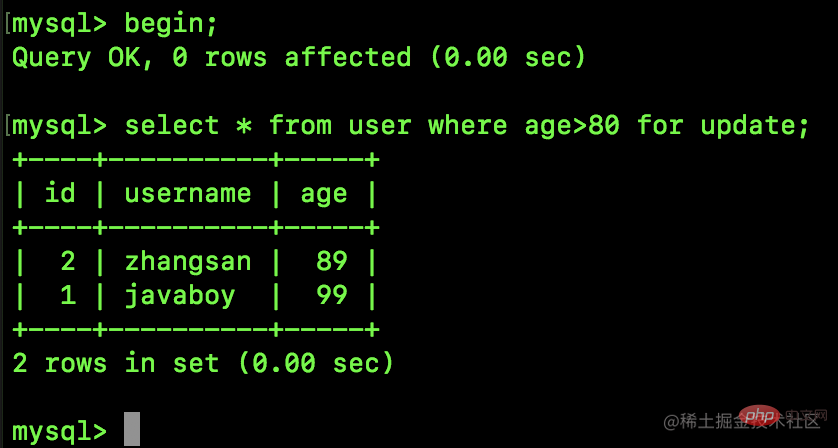An article to talk about the insertion intention lock in MySQL
In this article, we will talk about the insertion intention lock in MySQL and introduce what is the insertion intention lock? Why do I need to insert an intent lock? I hope to be helpful!

Insert Intention Lock, we also call it insertion intention lock in Chinese.
This can be regarded as a supplement to the Gap Lock we talked about before. Regarding Gap Lock, if you still don’t understand, you can refer to: Record Lock, Gap Lock and Next-Key Locks.
1. Why do we need to insert intention locks
We already had Gap Lock before. Gap Lock can help us solve the phantom read problem to a certain extent. However, before There seems to be some problem.
Suppose I have the following table:
CREATE TABLE `user` ( `id` int(11) unsigned NOT NULL AUTO_INCREMENT, `username` varchar(255) COLLATE utf8mb4_unicode_ci DEFAULT NULL, `age` int(11) NOT NULL, PRIMARY KEY (`id`), KEY `age` (`age`) ) ENGINE=InnoDB AUTO_INCREMENT=10 DEFAULT CHARSET=utf8mb4 COLLATE=utf8mb4_unicode_ci;
id is an auto-incremented primary key; age is an ordinary index. Now there is the following data in the table:

Suppose I want to execute the following insert SQL:
begin;insert into user(username,age) values('wangwu',95);
Note that this SQL is executed but the transaction has not yet been committed.
According to the knowledge we learned about Gap Lock before, the range of Gap Lock at this time is (89,99), which means that no age in this range can be inserted.
If this is the case, friends will find that the efficiency of data insertion is too low, and lock conflicts are prone to occur. So what should we do?
The insertion intention lock we are going to introduce today is used to solve this problem.
2. What is an insert intention lock?
Let’s take a look at the introduction on the MySQL official website:
An insert intention lock is a type of gap lock set by INSERT operations prior to row insertion. This lock signals the intent to insert in such a way that multiple transactions inserting into the same index gap need not wait for each other if they are not inserting at the same position within the gap . Suppose that there are index records with values of 4 and 7. Separate transactions that attempt to insert values of 5 and 6, respectively, each lock the gap between 4 and 7 with insert intention locks prior to obtain the exclusive lock on the inserted row , but do not block each other because the rows are nonconflicting.
The rough translation is this:
The insertion intention lock is a gap set before the INSERT operation Lock, insertion intention lock represents an insertion intention, that is, when multiple different transactions insert data into the same gap of the same index at the same time, they do not need to wait for each other, that is, they will not block (if you simply follow According to the previous gap lock theory, you must wait for a gap lock to be released before the next transaction can insert data into the same gap). Suppose there are index records with values 4 and 7. Now there are two transactions trying to insert records with values 5 and 6 respectively. Each transaction uses an insert intention lock to lock between 4 and 7 before obtaining the exclusive lock on the inserted row. gap, but the two transactions will not block each other because the rows do not conflict.
This is to insert the intention lock.
3. Practice
Friends, please note that Brother Song talked about Gap Lock with everyone before and said that this is the isolation level of REPEATABLE READ. A unique product, so now Insert Intention Lock is a special Gap Lock, which of course also takes effect under the isolation level of repeatable read.
Next, we will demonstrate the insertion of intention locks through two simple cases.
3.1 Case 1
Our table structure and data are consistent with the first section.
First we execute the following code in session A:

Now the transaction in session A is not committed.
Next we also perform an insert operation in session B:

We found that session B can also be executed normally without blocking.
This shows that the two insertion intention locks are compatible and can coexist.
3.2 Case 2
Let’s look at another incompatible example.
First execute the following SQL in session A to query records with age greater than 80, and add an exclusive lock:

Next in session B, execute the following The code inserts a row of data:

Friends, you can see that this operation will be blocked! The reason for blocking is that the insertion intention lock and the exclusive lock are mutually exclusive.
Taking advantage of the blocking situation, in session C, we use the show engine innodb status\G command used in the previous article to check the locking situation. Key points Look at the TRANSACTION node:

In the output content, the place where the red box is selected clearly indicates the existence of the insertion intention lock.
4. Summary
To summarize:
Inserting intention lock Although the name has the word intention, in fact It is a special gap lock.
Insertion intention locks are not mutually exclusive.
Insert mutual exclusion between intention lock and exclusive lock.
Okay, if you have any questions, please leave a message for discussion.
[Related recommendations: mysql video tutorial]
The above is the detailed content of An article to talk about the insertion intention lock in MySQL. For more information, please follow other related articles on the PHP Chinese website!

Hot AI Tools

Undresser.AI Undress
AI-powered app for creating realistic nude photos

AI Clothes Remover
Online AI tool for removing clothes from photos.

Undress AI Tool
Undress images for free

Clothoff.io
AI clothes remover

AI Hentai Generator
Generate AI Hentai for free.

Hot Article

Hot Tools

Notepad++7.3.1
Easy-to-use and free code editor

SublimeText3 Chinese version
Chinese version, very easy to use

Zend Studio 13.0.1
Powerful PHP integrated development environment

Dreamweaver CS6
Visual web development tools

SublimeText3 Mac version
God-level code editing software (SublimeText3)

Hot Topics
 How to fix mysql_native_password not loaded errors on MySQL 8.4
Dec 09, 2024 am 11:42 AM
How to fix mysql_native_password not loaded errors on MySQL 8.4
Dec 09, 2024 am 11:42 AM
One of the major changes introduced in MySQL 8.4 (the latest LTS release as of 2024) is that the "MySQL Native Password" plugin is no longer enabled by default. Further, MySQL 9.0 removes this plugin completely. This change affects PHP and other app
 Break or return from Java 8 stream forEach?
Feb 07, 2025 pm 12:09 PM
Break or return from Java 8 stream forEach?
Feb 07, 2025 pm 12:09 PM
Java 8 introduces the Stream API, providing a powerful and expressive way to process data collections. However, a common question when using Stream is: How to break or return from a forEach operation? Traditional loops allow for early interruption or return, but Stream's forEach method does not directly support this method. This article will explain the reasons and explore alternative methods for implementing premature termination in Stream processing systems. Further reading: Java Stream API improvements Understand Stream forEach The forEach method is a terminal operation that performs one operation on each element in the Stream. Its design intention is
 Create the Future: Java Programming for Absolute Beginners
Oct 13, 2024 pm 01:32 PM
Create the Future: Java Programming for Absolute Beginners
Oct 13, 2024 pm 01:32 PM
Java is a popular programming language that can be learned by both beginners and experienced developers. This tutorial starts with basic concepts and progresses through advanced topics. After installing the Java Development Kit, you can practice programming by creating a simple "Hello, World!" program. After you understand the code, use the command prompt to compile and run the program, and "Hello, World!" will be output on the console. Learning Java starts your programming journey, and as your mastery deepens, you can create more complex applications.
 Java Program to Find the Volume of Capsule
Feb 07, 2025 am 11:37 AM
Java Program to Find the Volume of Capsule
Feb 07, 2025 am 11:37 AM
Capsules are three-dimensional geometric figures, composed of a cylinder and a hemisphere at both ends. The volume of the capsule can be calculated by adding the volume of the cylinder and the volume of the hemisphere at both ends. This tutorial will discuss how to calculate the volume of a given capsule in Java using different methods. Capsule volume formula The formula for capsule volume is as follows: Capsule volume = Cylindrical volume Volume Two hemisphere volume in, r: The radius of the hemisphere. h: The height of the cylinder (excluding the hemisphere). Example 1 enter Radius = 5 units Height = 10 units Output Volume = 1570.8 cubic units explain Calculate volume using formula: Volume = π × r2 × h (4
 How to Run Your First Spring Boot Application in Spring Tool Suite?
Feb 07, 2025 pm 12:11 PM
How to Run Your First Spring Boot Application in Spring Tool Suite?
Feb 07, 2025 pm 12:11 PM
Spring Boot simplifies the creation of robust, scalable, and production-ready Java applications, revolutionizing Java development. Its "convention over configuration" approach, inherent to the Spring ecosystem, minimizes manual setup, allo
 Java Program to insert an element at the Bottom of a Stack
Feb 07, 2025 am 11:59 AM
Java Program to insert an element at the Bottom of a Stack
Feb 07, 2025 am 11:59 AM
A stack is a data structure that follows the LIFO (Last In, First Out) principle. In other words, The last element we add to a stack is the first one to be removed. When we add (or push) elements to a stack, they are placed on top; i.e. above all the
 The page is blank after PHP is connected to MySQL. What is the reason for the invalid die() function?
Apr 01, 2025 pm 03:03 PM
The page is blank after PHP is connected to MySQL. What is the reason for the invalid die() function?
Apr 01, 2025 pm 03:03 PM
The page is blank after PHP connects to MySQL, and the reason why die() function fails. When learning the connection between PHP and MySQL database, you often encounter some confusing things...
 How to Run Your First Spring Boot Application in IntelliJ?
Feb 07, 2025 am 11:40 AM
How to Run Your First Spring Boot Application in IntelliJ?
Feb 07, 2025 am 11:40 AM
IntelliJ IDEA simplifies Spring Boot development, making it a favorite among Java developers. Its convention-over-configuration approach minimizes boilerplate code, allowing developers to focus on business logic. This tutorial demonstrates two metho






